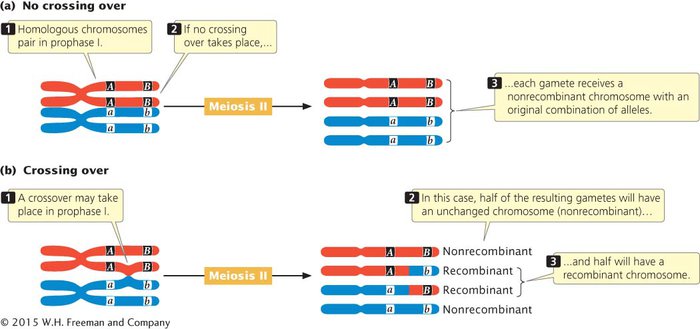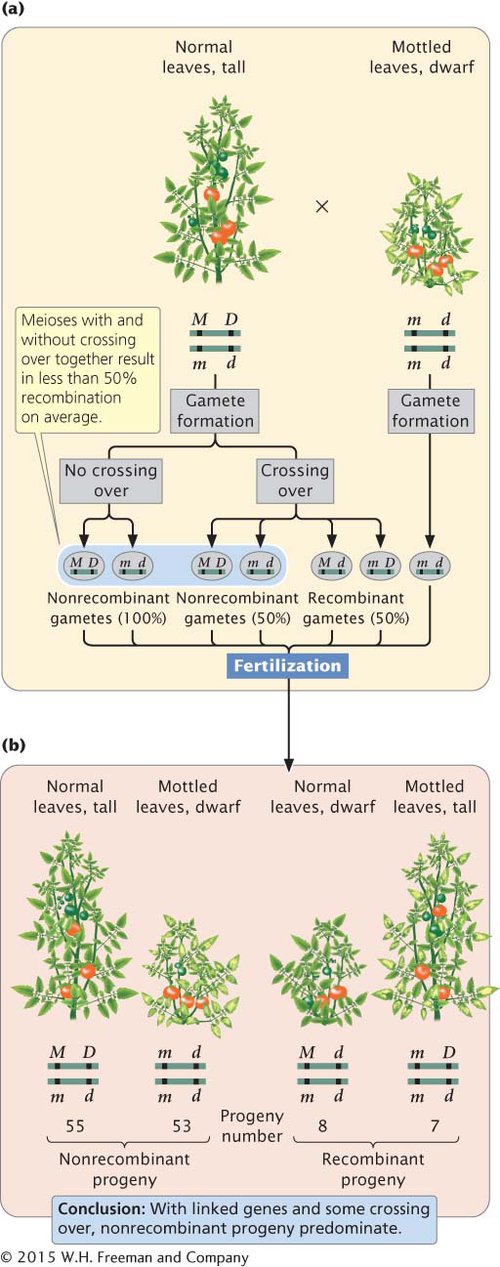Crossing Over Between Linked Genes
Usually, there is some crossing over between genes that lie on the same chromosome, which produces new combinations of traits. Genes that exhibit crossing over are said to be incompletely linked. Let’s see how incomplete linkage affects the results of a cross.
THEORY The effect of crossing over on the inheritance of two linked genes is shown in Figure 5.5. Crossing over, which takes place in prophase I of meiosis, is the exchange of genetic material between nonsister chromatids (see Figures 2.12 and 2.13). After a single crossover has taken place, the two chromatids that did not participate in crossing over are unchanged; gametes that receive these chromatids are nonrecombinants. The other two chromatids, which did participate in crossing over, now contain new combinations of alleles; gametes that receive these chromatids are recombinants. For each meiosis in which a single crossover takes place, two nonrecombinant gametes and two recombinant gametes will be produced. This result is the same as that produced by independent assortment (see Figure 5.4b), so if crossing over between two loci takes place in every meiosis, it is impossible to determine whether the genes are on the same chromosome and crossing over took place or whether the genes are on different chromosomes.

121
For closely linked genes, crossing over does not take place in every meiosis. In meioses in which there is no crossing over, only nonrecombinant gametes are produced. In meioses in which there is a single crossover, half the gametes are recombinants and half are nonrecombinants (because a single crossover affects only two of the four chromatids). Because each crossover leads to half recombinant gametes and half nonrecombinant gametes, the total percentage of recombinant gametes is always half the percentage of meioses in which crossing over takes place. Even if crossing over between two genes takes place in every meiosis, only 50% of the resulting gametes will be recombinants. Thus, the frequency of recombinant gametes is always half the frequency of crossing over, and the maximum proportion of recombinant gametes is 50%.
CONCEPTS
Linkage between genes causes them to be inherited together and reduces recombination; crossing over breaks up the associations of such genes. In a testcross for two linked genes, each crossover produces two recombinant gametes and two nonrecombinants. The frequency of recombinant gametes is half the frequency of crossing over, and the maximum frequency of recombinant gametes is 50%.
 CONCEPT CHECK 1
CONCEPT CHECK 1
For single crossovers, the frequency of recombinant gametes is half the frequency of crossing over because
a testcross between a homozygote and heterozygote produces ½ heterozygous and ½ homozygous progeny.
the frequency of recombination is always 50%.
each crossover takes place between only two of the four chromatids of a homologous pair.
crossovers take place in about 50% of meioses.
c
APPLICATION Let’s apply what we have learned about linkage and recombination to a cross between tomato plants that differ in the genes that encode leaf type and plant height. Assume now that these genes are linked and that some crossing over takes place between them. Suppose that a geneticist carried out the testcross described earlier:

When crossing over takes place between the genes for leaf type and height, two of the four gametes produced are recombinants. When there is no crossing over, all four resulting gametes are nonrecombinants. Because crossing over between two linked genes does not take place in all meioses, most of the gametes will be nonrecombinants. These gametes then unite with gametes produced by the homozygous recessive parent, which contain only the recessive alleles, resulting in mostly nonrecombinant progeny and a few recombinant progeny (Figure 5.6). In this cross, we see that 55 of the testcross progeny have normal leaves and are tall and that 53 have mottled leaves and are dwarf. These plants are the nonrecombinant progeny, containing the original combinations of traits that were present in the parents. Of the 123 progeny, 15 have new combinations of traits that were not seen in the parents: 8 have normal leaves and are dwarf, and 7 have mottled leaves and are tall. These plants are the recombinant progeny.

The results of a cross such as the one illustrated in Figure 5.6 reveal several things. A testcross for two independently assorting genes is expected to produce a 1 : 1 : 1 : 1 phenotypic ratio in the progeny. The progeny of this cross clearly do not exhibit such a ratio, so we might suspect that the genes are not assorting independently. When linked genes undergo some crossing over, the result is mostly nonrecombinant progeny and fewer recombinant progeny. This result is what we observe among the progeny of the testcross illustrated in Figure 5.6, so we conclude that the two genes show evidence of linkage with some crossing over.